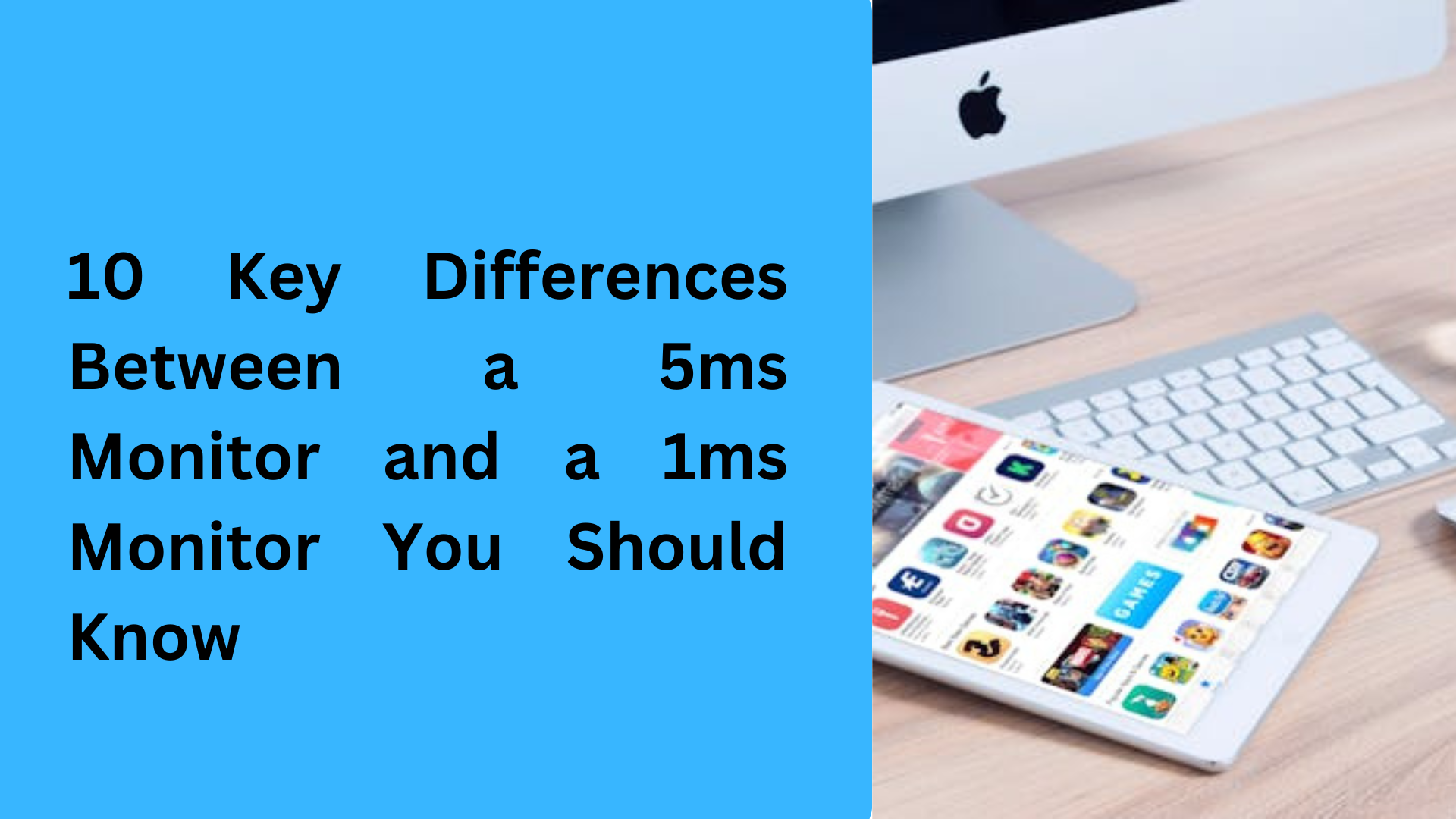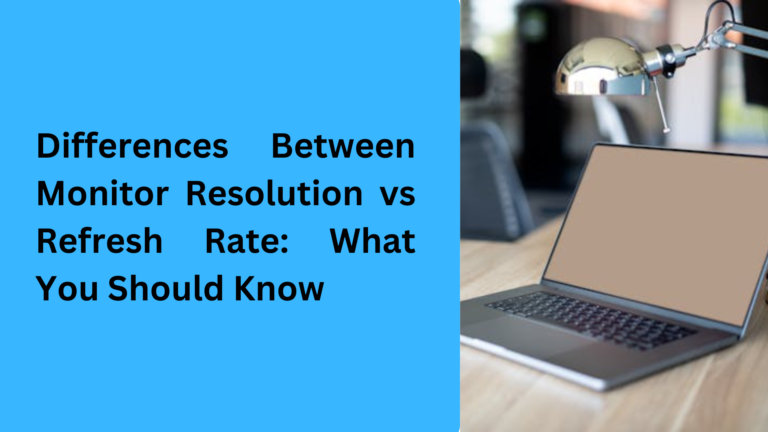10 Key Differences Between a 5ms Monitor and a 1ms Monitor You Should Know
When shopping for a monitor, you’ve probably come across terms like 5ms and 1ms. These numbers refer to the response time of the display, but what exactly does that mean for you as a user? In this guide, we’ll explain the top 5 differences between a 5ms monitor and a 1ms monitor so you can make an informed decision. Whether you’re looking for a gaming monitor, working on productivity, or just enjoying media, understanding these terms will help you choose the right monitor for your needs.
1. What Does Response Time Mean in a 5ms vs 1ms Monitor?
When comparing a 5ms monitor and a 1ms monitor, the primary difference lies in their response time. The response time is how quickly a pixel can change from one color to another, which directly impacts motion blur and screen ghosting in fast-moving visuals. A 1ms response time ensures smoother transitions and less blur, which is crucial for gamers who require ultra-fast action clarity. In contrast, a 5ms monitor is still quite good for general use and casual gaming, but the response time is slower, meaning there might be a slight motion blur during fast-paced action.
For users seeking fast-paced action clarity, especially in first-person shooters or competitive games, a 1ms monitor provides an edge. However, if you’re doing graphic design, photo editing, or watching movies, the 5ms monitors offer excellent performance for everyday tasks, even though they aren’t as fast as the 1ms options.
2. Impact on Gaming Performance: 1ms vs 5ms
If you’re a gamer aiming for the best possible performance, the difference between a 5ms and a 1ms monitor can be crucial. Gamers who play fast games like Counter-Strike, Fortnite, or Call of Duty will notice that the 1ms monitor delivers a significantly more responsive experience. With reduced motion blur and input lag, the visuals feel more in sync with your movements, which is essential for competitive gaming.
However, for casual gamers, the 5ms monitor might be more than sufficient. While the 1ms monitors have an advantage in speed and reaction time, 5ms monitors offer solid performance for single-player games or games that don’t require ultra-fast inputs. If you are not into e-sports or high-speed action games, a 5ms response time should provide a smooth and enjoyable gaming experience.
3. Visual Clarity and Motion Blur in a 1ms vs 5ms Monitor
The visual clarity and motion blur of a monitor are greatly influenced by its response time. A 1ms monitor can handle quick changes in visuals without ghosting, leading to sharper and more clear images during fast motion. This is especially useful in games where split-second decisions can make the difference between victory and defeat. On the other hand, a 5ms monitor may still produce motion blur during fast movement, making it less ideal for quick-paced games or any task requiring high precision.
For activities like watching videos or editing photos, where motion blur isn’t as critical, the 5ms response time will not have a noticeable impact. For most users who are not heavily focused on e-sports gaming or ultra-fast action, a 5ms monitor will still offer an enjoyable visual experience.
4. Difference in Input Lag: 1ms vs 5ms Monitors
Input lag is another key area where 5ms monitors and 1ms monitors differ. Input lag refers to the delay between your actions (like moving the mouse or pressing a key) and the corresponding response on the screen. A 1ms monitor has a much lower input lag, making it ideal for gamers who need an instant response when they make a move. This gives players a competitive edge in online multiplayer games where milliseconds can determine the outcome.
On the other hand, a 5ms monitor may have a slightly higher input lag, but for non-competitive gaming or regular office work, this minor delay will likely go unnoticed. It’s only in highly competitive situations that the slight delay in response time may affect performance.
5. Price and Availability of 1ms vs 5ms Monitors
One important consideration when choosing between a 1ms monitor and a 5ms monitor is the price. 1ms monitors are generally more expensive due to their advanced technology and faster performance. Gamers and professionals who need the absolute best performance are willing to pay a premium for that extra speed and responsiveness.
In contrast, 5ms monitors are more affordable and offer great value for everyday tasks. For students, general office work, or casual content consumption, a 5ms monitor will provide excellent performance at a more budget-friendly price. You’ll find 5ms monitors available in a wider range of models, often with features like high refresh rates and good color accuracy for multimedia work.
6. Screen Refresh Rate Compatibility: 1ms vs 5ms Monitors
When choosing between a 1ms monitor and a 5ms monitor, it’s essential to consider the refresh rate of the screen as well. The refresh rate determines how often the screen updates its image per second, typically measured in Hz (Hertz). Monitors with 1ms response time are often paired with higher refresh rates (like 144Hz, 240Hz, or even 360Hz), which enhances the fluidity of motion and makes them perfect for high-performance gaming and competitive play.
In comparison, 5ms monitors typically come with lower refresh rates like 60Hz or 75Hz, which can be sufficient for casual users who don’t require ultra-smooth visuals. If you play fast-paced multiplayer games or need higher resolution and fluidity, a 1ms monitor with a higher refresh rate will offer you a smoother and more responsive experience. But for those using the monitor for media consumption or day-to-day office tasks, a 5ms monitor with a standard refresh rate should do the job just fine.
7. Color Accuracy and Visual Experience: 5ms vs 1ms Monitors
When deciding between a 5ms and a 1ms monitor, color accuracy and visual quality may play a crucial role, especially for tasks like photo editing, video production, or graphic design. While the response time primarily affects motion clarity, the color accuracy can also differ between these monitors. Many 1ms monitors are built with gaming and high-performance in mind, focusing on quick response times and often sacrificing some aspects of color calibration or accuracy in favor of speed.
On the other hand, 5ms monitors are often optimized for tasks that require more precise color reproduction and better contrast levels. For instance, if you’re working in design or enjoy watching high-definition movies, the 5ms monitors may provide better visual quality, with more vibrant and accurate colors, though the 1ms monitors will still perform excellently in most settings. If color fidelity and visual immersion matter to you, a 5ms monitor may be the better choice.
8. Long-Term Durability: 1ms vs 5ms Monitors
In terms of durability, there’s no clear-cut winner between the 1ms and 5ms monitors. Both types of monitors are built to last and are often available with extended warranties. However, 1ms monitors are usually marketed towards serious gamers and professionals who are looking for the fastest technology, which means they may come with advanced features such as higher refresh rates, adaptive sync, and overclocking options. These features can sometimes lead to higher power consumption or heat generation, potentially affecting the long-term durability of the monitor if not managed correctly.
Meanwhile, 5ms monitors, being designed for more general use, are often built with simpler components and less emphasis on high-speed gaming technology. This makes them slightly more energy-efficient and can potentially lead to longer-term durability in less demanding conditions. However, both types of monitors should last for many years with proper care, and the difference in durability is usually negligible unless you plan on pushing the monitor to its limits with intensive gaming.
9. Use Cases: 1ms vs 5ms Monitors for Different Tasks
Another important factor when deciding between 1ms and 5ms monitors is understanding which tasks each type of monitor excels at. For high-intensity gaming, video editing, or real-time data analysis, a 1ms monitor is ideal because of its quick response times and minimal input lag, providing the best performance when every millisecond counts.
For those who primarily use a monitor for office work, emailing, web browsing, or media consumption, a 5ms monitor is more than enough. These activities don’t require the super-fast response times of a 1ms monitor, and you can still enjoy smooth visuals and good performance at a lower price point.
In general, consider what activities you’ll be using the monitor for. If you’re a streamer, competitive gamer, or someone who requires top-tier performance, the 1ms monitor will give you an edge. For users who spend most of their time on productivity or entertainment, the 5ms monitor will deliver everything you need without unnecessary extra speed.
10. Energy Consumption: 1ms vs 5ms Monitors
An often overlooked aspect of choosing a 1ms monitor versus a 5ms monitor is their energy consumption. 1ms monitors—especially those designed for gaming—often feature high refresh rates and advanced technologies like G-Sync or FreeSync, which can increase the power requirements. These monitors are typically larger and brighter, consuming more energy during use. This could be a consideration if you’re concerned about your electricity bill or want to reduce energy usage in your home or office.
In contrast, 5ms monitors are generally more energy-efficient, requiring less power due to their simpler specifications. For casual users who don’t need the fastest response time and are conscious about power consumption, a 5ms monitor might be a better choice, helping you save a little on your monthly energy costs.
Frequently Asked Questions (FAQs) About 5ms vs 1ms Monitors
1. What is the difference between a 1ms and 5ms monitor in terms of gaming performance?
The primary difference between a 1ms monitor and a 5ms monitor for gaming is the response time. A 1ms gaming monitor offers faster response times, reducing motion blur and input lag, which is crucial for competitive gaming and e-sports where every millisecond counts. For casual or non-competitive gamers, a 5ms monitor for gaming is still a great choice, offering smooth visuals without the ultra-low response time required for high-end gaming.
2. Is a 1ms monitor better for competitive gamers than a 5ms monitor?
Yes, a 1ms monitor is ideal for competitive gamers who need lightning-fast performance and the lowest input lag possible. This response time ensures minimal motion blur and immediate feedback during fast-paced games. However, for casual gaming or general use, a 5ms monitor will still deliver a great experience with slightly higher but still acceptable input lag.
3. Can a 5ms monitor handle high-definition content like a 1ms monitor?
Yes, a 5ms monitor can easily handle high-definition content such as movies, videos, and images with excellent color reproduction and visual quality. While the 1ms monitors may have better performance for fast motion, a 5ms monitor for multimedia use provides a vibrant viewing experience for those who prioritize color accuracy and image clarity over extreme speed.
4. What should I look for in a monitor if I want to avoid motion blur, a 5ms vs 1ms comparison?
To avoid motion blur, a 1ms monitor is your best option, especially if you’re playing fast-paced games like first-person shooters or action-packed titles. A 1ms response time monitor minimizes ghosting and ensures smooth transitions between frames. On the other hand, a 5ms monitor will still work fine for less intense gaming or office use, but you may notice some slight motion blur in extremely fast-moving visuals.
5. Is a 5ms monitor more energy-efficient compared to a 1ms monitor?
Yes, a 5ms monitor is typically more energy-efficient than a 1ms monitor, especially those designed for high-performance gaming with additional features like higher refresh rates and adaptive sync technologies. For everyday tasks like browsing, working, or watching media, a 5ms monitor consumes less power and can help you save on electricity costs while still providing good performance.


